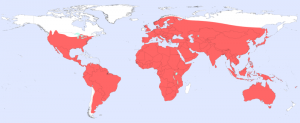A Better, Cheaper Treatment for Poisonous Snake Bites
Brad Brooks and Zhiguo Zhou, Luna Labs
有毒的蛇是发现世界各地。在the tropical world, where they are most abundant and there is limited access to emergent medical care, they are a significant threat to public health. The World Health Organization (WHO) has designated “snakebites” as a Neglected Tropical Disease, seriously injuring 2.7 million men, women and children, and claiming some 125,000 lives every year.1There are more than 600 species of venomous snakes worldwide, and over 200 are considered medically important by the WHO.

Current treatments require species-specific antivenom, so even though total envenomations (bites with injection of venom) can be high worldwide, the market for any one antivenom is relatively small. Wyeth Pharmaceuticals (acquired by Pfizer) stopped producing CSAV that was primarily used to treat North American coral snake envenomations. And Sanofi stopped supplying Fav-Afrique, the only antivenom proven safe and effective to treat snake bites in Sub-Saharan regions. In addition, the antivenom manufacture uses animals (e.g. goats and horses) so the serum immunoglobulin needs to be refrigerated and administered in an intensive care unit (ICU) to deal with “serum sickness”, the patient’s rejection of the animal antibodies.
All of these factors – low competition, high manufacturing costs, and high administration costs in an ICU – lead to very expensive treatment for snake bites. US hospitals can charge more than $150,000 to treat one snake bite. In at least one instance more than half of the charges (~$83,000) went to pharmacy costs for the antivenom medicine.2-3
Ideally a single antivenom medicine would offer broad spectrum protection against common venomous species without the need for accurate species identification. And it would be stored and safely administered anywhere in the world. To meet this need, Luna is developing a synthetic universal antivenom. Using biomimetic “sticky” nanoparticles, Luna’s antivenom selectively captures a broad range of venomous toxins that are primarily responsible for its lethality and local tissue damages. The sequestered toxins are neutralized and removed from the body naturally, reducing the overall concentration and enhancing the survival rate. Nanoparticles, due to their high surface area to mass ratio, dramatically increase the neutralizing capacity compared to that of immunoglobulin. Current treatments typically require continuous intravenous infusion of hundreds if not thousands of milliliters of saline that contains multiple grams of immunoglobulins over a period of several hours. While still under preclinical investigation, the higher surface area of the nanoparticles could mean a reduction of antivenom dose and a shorter time to take effect.
The synthetic nanoparticle approach is a practically useful method for producing clinically relevant quantities of antivenom at very low costs starting with readily available compounds. These nanoparticles are stable at ambient conditions, eliminating the need of cold chain transport and storage (refrigeration), which is a huge benefit for emergent medicines in rural tropics and other resource-limited regions.
Luna’s antivenom drug candidate is currently being evaluated in preclinical animal studies for safety and efficacy. Representative snake venoms from the elapidae (e.g. mamba and cobra) and viperidae (e.g. puff adder) families are used to test its efficacy in WHO recommended animal models. If successful, the antivenom nanomedicine will provide much needed help for civilians in high risk regions and may also add a unique medical countermeasure capability to the U.S. military Special Operational Forces who are deployed in austere areas of Africa and Asia and are particularly at risk for encounters with venomous snakes. This universal antivenom technology is funded by the Department of Defense through its DARPA SBIR program.